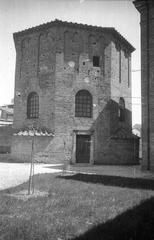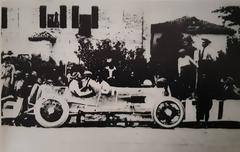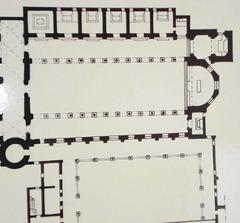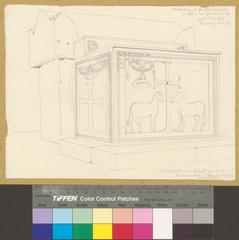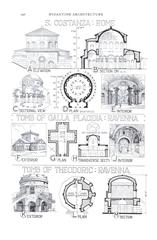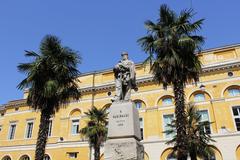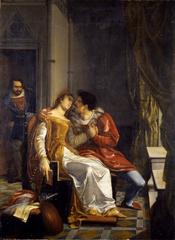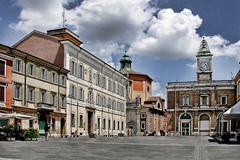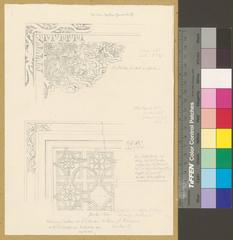Monumento ad Anita Garibaldi Ravenna: Visiting Hours, Tickets, and Complete Guide
Date: 03/07/2025
Introduction
Nestled in the heart of Ravenna, Italy, the Monumento ad Anita Garibaldi stands as a profound tribute to one of the most emblematic figures of the Italian Risorgimento. This monument, located in Piazza Anita Garibaldi, honors Anita Garibaldi—a Brazilian-born revolutionary and the courageous wife and comrade-in-arms of Giuseppe Garibaldi. Remembered as the “Heroine of the Two Worlds,” Anita’s legacy is immortalized through this evocative monument, intertwining her personal sacrifices with the broader ideals of liberty, patriotism, and national identity.
This comprehensive guide covers the monument’s historical background, artistic symbolism, practical visitor information (including visiting hours, ticketing, accessibility, and travel tips), as well as insights into its urban context and community significance. Whether you are a history enthusiast, art lover, or casual traveler, this resource will ensure a meaningful and seamless experience during your visit to Ravenna.
For additional planning resources and up-to-date information, refer to official and dedicated cultural platforms (Heroes of Adventure, Il Romagnolo, Turismo Ravenna).
Table of Contents
- Origins and Historical Context
- Artistic Symbolism and Design
- Anita Garibaldi: Legacy and National Identity
- The Monument’s Political Role
- Visiting Information
- Urban Context: Piazza Anita Garibaldi
- Nearby Attractions
- Community Engagement and Events
- Practical Tips
- Frequently Asked Questions (FAQ)
- Conclusion
- References
Origins and Historical Context
The Monumento ad Anita Garibaldi is deeply rooted in the city’s connection to the Risorgimento, the 19th-century movement for Italian unification. The idea for a monument arose soon after Italy’s unification, reflecting a nationwide effort to commemorate those who sacrificed for independence. A local commission was established in 1867 to honor the fallen heroes, and after overcoming financial and organizational hurdles, a public competition selected Cesare Zocchi’s neoclassical design. The monument was finally inaugurated on September 1, 1888, embodying both local pride and national memory (Heroes of Adventure, IGotoWorld).
Artistic Symbolism and Design
Sculptural Composition and Iconography
Zocchi’s monument is rich in neoclassical artistry and patriotic symbolism. At its center stands a female figure in medieval armor—an allegorical personification of liberty or of Ravenna itself—placing a laurel wreath on the head of a fallen soldier. In her other hand, she holds a shield with Ravenna’s coat of arms, visually connecting local and national identity.
The monument is flanked by four bronze lions at its base, each representing a pivotal year in the Italian Wars of Independence: 1831, 1848, 1859, and 1870. These lions symbolize vigilance, strength, and the enduring struggle for freedom (Il Romagnolo).
Bronze bas-reliefs on the pedestal depict two crucial episodes from Anita’s life: her heroic river crossing on horseback and her tragic death at the Guiccioli farmstead near Ravenna. The choice of durable bronze and stone, along with classical motifs, situates the monument firmly within Italy’s tradition of civic sculpture.
Inscription and Dedication
The monument’s inscription reveals its dual purpose: “To Anita, wife and companion in glory and misfortune of Giuseppe Garibaldi… and to the people of Ravenna who died on the scaffold, in prisons, in war, and in exile.” This dedication bridges personal heroism and communal sacrifice, reflecting a unified commemoration (Il Romagnolo).
Anita Garibaldi: Legacy and National Identity
Anita Garibaldi’s transformation from a historical figure into a national icon was fueled by romanticized biographies, poems, and public commemorations. Her brief but significant involvement in European revolutionary campaigns and her dramatic death in 1849 near Ravenna cemented her status in Italian memory.
The monument’s imagery—depicting Anita as both a nurturing mother and a fighter—embodies the dual ideals of nurturing and resistance central to the Risorgimento’s identity (Academia.edu).
The Monument’s Political Role
Over time, Anita’s legacy and the monument’s symbolism were variously interpreted and appropriated, notably during the Fascist era. The Risorgimento’s ideals were often re-framed to fit contemporary political agendas, emphasizing themes of patriotism and revolutionary fervor while downplaying democratic and internationalist aspects (Academia.edu). Despite these shifts, the monument has retained its prominence as a site of public commemoration and civic pride.
Visiting Information
Opening Hours
Piazza Anita Garibaldi and the monument are open to the public year-round, 24 hours a day. Daylight hours (typically 8:00 AM to 8:00 PM in warmer months) are ideal for enjoying the monument and its details.
Ticketing
There is no admission fee or ticket required—the monument and piazza are freely accessible to all visitors.
Accessibility
The square offers smooth, level surfaces, ramps, and nearby benches, ensuring accessibility for wheelchair users and those with mobility challenges. Public transport stops and parking are conveniently located nearby (Turismo Ravenna).
Directions & Getting There
Piazza Anita Garibaldi is centrally located, a short walk from Ravenna’s main train station and close to major bus lines. Car parking options are available near the station, and the piazza is easily reachable by foot, bicycle, or public transport (Turismo Ravenna).
Guided Tours and Events
Local tourism offices and operators offer guided tours focusing on Ravenna’s Risorgimento history, often including the monument. The site hosts commemorative ceremonies and cultural events, especially on anniversaries linked to Italian unification. Check the Ravenna tourism office or official event calendars for schedules (Turismo Ravenna).
Urban Context: Piazza Anita Garibaldi
Piazza Anita Garibaldi is a vibrant urban space within Ravenna’s historic core. It features a harmonious blend of historical and contemporary elements, with mosaic pavements inspired by the city’s Byzantine heritage (ResearchGate). The square is surrounded by important civic buildings, schools, and cafes, and is a hub for community gatherings, cultural events, and daily life.
Nearby Attractions
While visiting Piazza Anita Garibaldi, explore other key Ravenna landmarks within walking distance:
- Basilica di San Giovanni Evangelista: Renowned for its medieval architecture and mosaics.
- Arian Baptistry: Celebrated for early Christian mosaics and UNESCO World Heritage status.
- Dante Museum and Tomb: Dedicated to the life and legacy of Dante Alighieri.
- Mausoleum of Galla Placidia and Basilica di San Vitale: Iconic sites for Ravenna’s UNESCO-listed mosaics.
The compact city center makes it easy to combine your visit with these historical treasures (Arrivals Hall).
Community Engagement and Events
The piazza functions as a vital civic center, hosting annual commemorations, cultural festivals, and open-air concerts. Local schools, cultural groups, and historical associations regularly organize educational activities, ensuring the site remains a living part of Ravenna’s social fabric (Ravenna Festival). Restoration projects and archaeological discoveries, such as Roman-era mosaics now exhibited at the TAMO Museum, add to the site’s cultural richness.
Practical Tips
- Best Times to Visit: Early mornings or late afternoons offer optimal lighting and fewer crowds.
- Amenities: Benches, shaded areas, and nearby cafes make the piazza comfortable for all visitors.
- Photography: The monument, lions, and mosaic pavements provide excellent photo opportunities.
- Contact Information: Ravenna tourism office: +39 0544 35404 or [email protected].
Frequently Asked Questions (FAQ)
Q: What are the opening hours of Piazza Anita Garibaldi and the monument?
A: The square is open to the public 24/7.
Q: Is there an admission fee to visit?
A: No, access to the piazza and monument is free.
Q: Are guided tours available?
A: Yes, through the Ravenna tourism office and local tour operators.
Q: Is the site wheelchair accessible?
A: Yes, the square features level surfaces and ramps.
Q: What other attractions are nearby?
A: The Basilica di San Giovanni Evangelista, Rocca Brancaleone, and UNESCO-listed mosaics are all within walking distance.
Conclusion
The Monumento ad Anita Garibaldi is both a work of art and a living symbol of Ravenna’s—and Italy’s—journey toward unity, liberty, and shared identity. Its powerful neoclassical design, historical resonance, and central urban location make it a must-visit for anyone seeking to understand the complexities and passions of the Risorgimento era. Whether you are exploring Ravenna’s artistic heritage, attending a commemorative event, or simply enjoying the vibrant atmosphere of Piazza Anita Garibaldi, the monument offers a meaningful encounter with Italy’s past and present.
For the most up-to-date information on visiting hours, tours, and events, download the Audiala app, check official tourism websites, and follow local cultural social channels.
References and Further Reading
- Heroes of Adventure – Piazza Anita Garibaldi
- Il Romagnolo – Statua di Anita Garibaldi a Ravenna
- ResearchGate – Virtual Mosaic Restoration
- Turismo Ravenna – Piazza Anita Garibaldi
